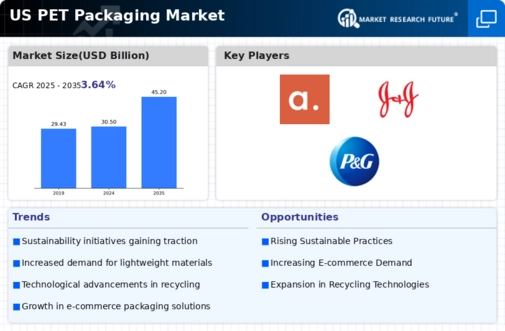The pet packaging market is currently characterized by a dynamic competitive landscape, driven by increasing consumer demand for sustainable and innovative packaging solutions. Key players such as Amcor (AU), Sealed Air (US), and Berry Global (US) are actively shaping the market through strategic initiatives focused on sustainability, technological advancements, and regional expansion. Amcor (AU) has positioned itself as a leader in sustainable packaging, emphasizing its commitment to reducing environmental impact through innovative materials and processes. Meanwhile, Sealed Air (US) is leveraging its expertise in protective packaging to enhance product safety and reduce waste, while Berry Global (US) is focusing on expanding its product portfolio to meet diverse consumer needs, thereby enhancing its competitive edge.
The business tactics employed by these companies include localizing manufacturing to reduce lead times and optimize supply chains, which appears to be a critical strategy in the current market environment. The competitive structure of the pet packaging market is moderately fragmented, with several key players exerting influence over market dynamics. This fragmentation allows for a variety of innovative solutions to emerge, as companies strive to differentiate themselves in a crowded marketplace.
In October 2025, Amcor (AU) announced a partnership with a leading pet food manufacturer to develop fully recyclable packaging solutions. This collaboration is strategically significant as it aligns with Amcor's sustainability goals and addresses the growing consumer demand for eco-friendly packaging options. The partnership not only enhances Amcor's product offerings but also strengthens its market position by tapping into the expanding pet food sector.
In September 2025, Sealed Air (US) launched a new line of biodegradable packaging materials specifically designed for pet products. This initiative reflects Sealed Air's commitment to sustainability and innovation, potentially positioning the company as a frontrunner in the eco-conscious segment of the pet packaging market. The introduction of biodegradable options may attract environmentally aware consumers, thereby expanding Sealed Air's market share.
In August 2025, Berry Global (US) expanded its manufacturing capabilities by investing in a new facility dedicated to producing sustainable pet packaging solutions. This strategic move is likely to enhance Berry's operational efficiency and responsiveness to market demands, while also reinforcing its commitment to sustainability. The investment may enable Berry to capture a larger share of the growing market for eco-friendly packaging solutions.
As of November 2025, current competitive trends in the pet packaging market are increasingly defined by digitalization, sustainability, and the integration of artificial intelligence (AI) in production processes. Strategic alliances among key players are shaping the landscape, fostering innovation and collaboration. Looking ahead, competitive differentiation is expected to evolve, with a notable shift from price-based competition to a focus on innovation, technology, and supply chain reliability. Companies that prioritize these aspects are likely to thrive in an increasingly competitive environment.














Leave a Comment